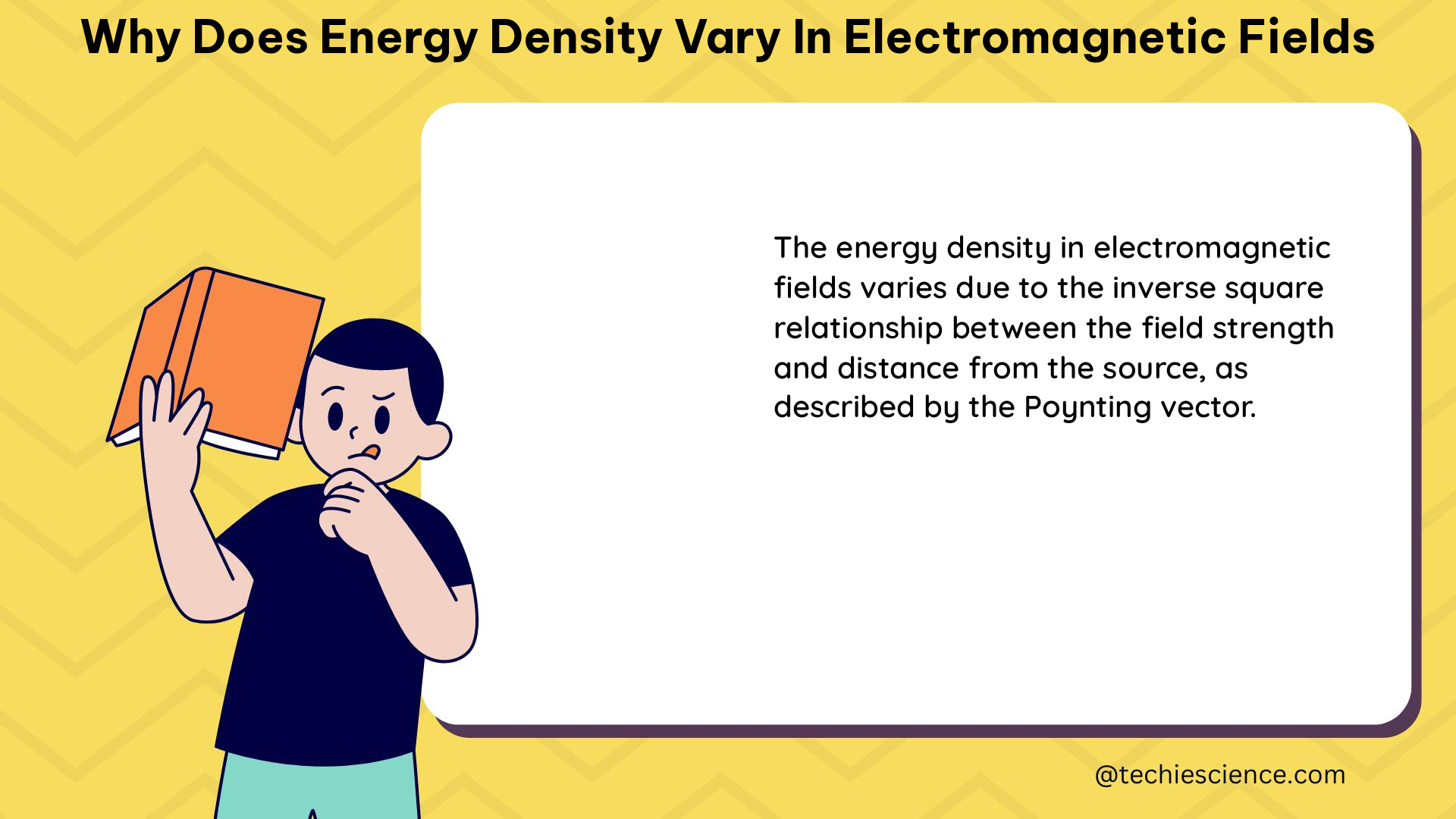The energy density of an electromagnetic wave is determined by the strength of the electric and magnetic fields that make up the wave. This energy density can vary depending on several factors, including the strength of the fields, the frequency of the wave, and the medium through which the wave is traveling. Understanding these factors is crucial for understanding how electromagnetic waves transfer energy and interact with different materials.
Factors Affecting Energy Density in Electromagnetic Fields
Electric and Magnetic Field Strength
The energy density of an electromagnetic wave is given by the sum of the electric field energy density and the magnetic field energy density. The electric field energy density is given by the formula:
1/2 * ε * E^2
where ε is the permittivity of the medium and E is the electric field strength. The magnetic field energy density is given by the formula:
1/2 * μ * H^2
where μ is the permeability of the medium and H is the magnetic field strength.
The electric and magnetic fields of an electromagnetic wave are related by the wave equation, which states that the electric field strength is equal to the speed of light times the magnetic field strength. This means that if the magnetic field strength is increased, the electric field strength will also increase, and the energy density of the wave will increase.
Frequency of the Wave
The energy density of an electromagnetic wave is also proportional to the frequency of the wave. Higher frequency waves have a higher energy density than lower frequency waves. This is because the energy of a wave is directly proportional to its frequency, as described by the Planck-Einstein relation:
E = h * f
where E is the energy of the wave, h is Planck’s constant, and f is the frequency of the wave.
Medium of Propagation
The medium through which an electromagnetic wave is traveling can also affect its energy density. The permittivity and permeability of the medium can influence the strength of the electric and magnetic fields, and therefore the energy density of the wave.
For example, a wave traveling through a medium with a high permittivity, such as water, will have a lower electric field strength and a lower energy density than a wave traveling through a medium with a low permittivity, such as free space. This is because the high permittivity of the medium “shields” the electric field, reducing its strength.
Similarly, the permeability of the medium can also affect the magnetic field strength and the energy density of the wave. A medium with a high permeability will tend to have a stronger magnetic field and a higher energy density than a medium with a low permeability.
Examples of Energy Density Variation

To illustrate the variation in energy density, let’s consider an electromagnetic wave with a frequency of 1 GHz and an electric field strength of 1 V/m, traveling through different media:
| Medium | Permittivity (ε) | Permeability (μ) | Electric Field Energy Density (J/m^3) | Magnetic Field Energy Density (J/m^3) | Total Energy Density (J/m^3) |
|---|---|---|---|---|---|
| Free Space | 8.85 x 10^-12 F/m | 4π x 10^-7 N/A^2 | 4.43 x 10^-10 | 1.33 x 10^-10 | 5.76 x 10^-10 |
| Glass | 6.2 x 10^-12 F/m | 4π x 10^-7 N/A^2 | 2.94 x 10^-10 | 1.33 x 10^-10 | 4.27 x 10^-10 |
| Water | 80 x 10^-12 F/m | 4π x 10^-7 N/A^2 | 3.54 x 10^-8 | 1.33 x 10^-10 | 1.37 x 10^-8 |
As you can see, the energy density of the wave is highest in free space, where the permittivity and permeability are at their lowest. The energy density is lowest in water, where the permittivity is much higher than in free space.
Practical Implications
The variation in energy density of electromagnetic waves has important practical implications. For example, in wireless communication systems, the energy density of the transmitted signal can affect the range and quality of the communication. Higher energy density signals can travel farther and be received with better signal-to-noise ratio.
Similarly, in medical applications, the energy density of electromagnetic radiation can be used to heat or ablate tissue, as in the case of microwave ablation therapy for cancer treatment. Understanding the factors that affect energy density is crucial for designing and optimizing these types of systems.
Conclusion
In summary, the energy density of an electromagnetic wave can vary depending on the strength of the electric and magnetic fields, the frequency of the wave, and the medium through which the wave is traveling. By understanding these factors, we can better understand how electromagnetic waves transfer energy and how they interact with different materials, which has important practical applications in fields such as wireless communication and medical technology.
References
- “Properties of Electromagnetic Waves” by Dr. John Kitchin, https://www.eskimo.com/~kitchin/ie302/emwaves.html
- “Electromagnetic Waves” by Dr. James R. Girgis, https://www.hep.ucl.ac.uk/u/jrg/teaching/em/node1.html
- “Electromagnetic Waves” by Dr. Chris Tanner, https://www.physics.ox.ac.uk/sites/default/files/2018-09/Tanner%20EM%20Waves%202018.pdf

The lambdageeks.com Core SME Team is a group of experienced subject matter experts from diverse scientific and technical fields including Physics, Chemistry, Technology,Electronics & Electrical Engineering, Automotive, Mechanical Engineering. Our team collaborates to create high-quality, well-researched articles on a wide range of science and technology topics for the lambdageeks.com website.
All Our Senior SME are having more than 7 Years of experience in the respective fields . They are either Working Industry Professionals or assocaited With different Universities. Refer Our Authors Page to get to know About our Core SMEs.